Oculus Rift Virtual Reality Initial Impressions
Here are my impressions after having the Oculus Development Kit (DK2) in-hand for a bit over two weeks now:
The Technology Behind Oculus
The hardware itself will be familiar to anyone who has developed software for a touch screen phone. Described generally, the head-mounted display is a cell phone screen placed in a headset mount. A gyroscope, magnetometer and accelerometer provide instrumentation, with an accompanying camera used to identify the position of the wearer's head. In all, the DK2 seems a perfect example of innovation, where the device introduces no new technologies but is instead a recombination of existing parts to create something wholly new.
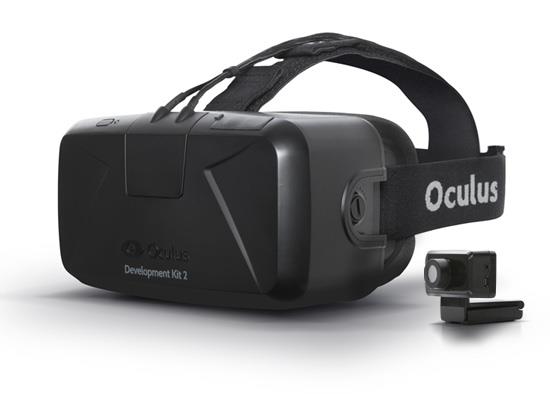
That doesn't in any way diminish how much of a marvel the device is, but it does suggest that, as with cell phones, VR headsets are likely to drop in price when created in volume and may be expected to improve in quality at a rapid pace.
Oculus Immersion
The screen's low resolution does produce a bit of a 'screen door' effect, with the LCD pixels very easy to see. The sensation is a bit like sitting too close to an old CRT television set. Since the DK2 is a prototype development kit (and not the final product) that lower image quality wasn't surprising, and I found the immersive experience of the headset allowed me to very quickly dismiss quibbles about resolution.
The sense of presence is very effective. Even with the 'seated at a desk' test display, I found myself reaching out to confirm that what I saw on the desk before me wasn't actually there . It's clear that the environment one is looking at is a set of video game graphics, but one's mind is easily convinced that what is being seen is actually real.
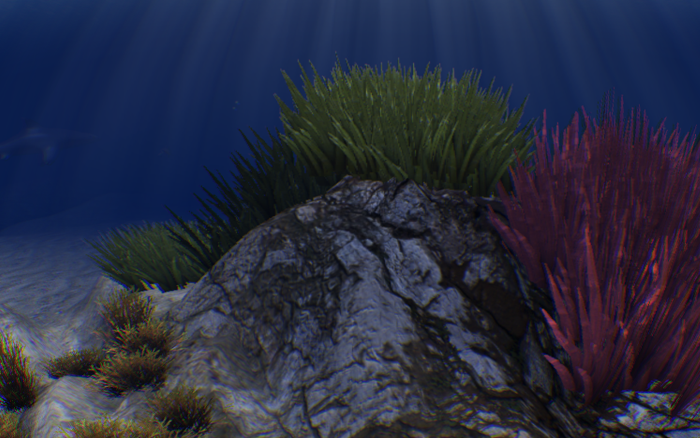
Along with that immersion, an awareness of my actual surroundings disappeared almost entirely at times, and I sometimes found myself startled to feel my hands touch a desk or chair when my eyes saw open air around me. I'm not sure if I would trust myself walking with a VR headset, and it will be interesting to see how Steam VR overcomes that sense of displacement from reality with their own plans for a headset which encourages standing, mobile user operation.
In the virtual environment, I felt a sense of apprehension whenever deliberately putting myself in danger. For one example, when swimming about in the Ocean Rift demo, I was reluctant to descend into the depths where the giant shark (which you're warned about) was waiting to attack. Even though I was obviously not really swimming beneath the waves and diving deep into a dark ocean trench, it was a spookily genuine experience all the same. Given my uneasiness with something so tame and G-rated, there is no way in hell I'd play a horror game like Alien Isolation in VR.
It will be interesting to see if that sense of dread diminishes once my brain becomes accustomed to the VR environment and learns about a new thing it can safely ignore. I remember telling my friends about the sense of total immersion I felt playing a pixelated 3D Quake, 640x480, on a 14 inch monitor, and I can't help but wonder if my initial Oculus experiences will sound just as exaggeratedly real when looking back on this technology in the future.
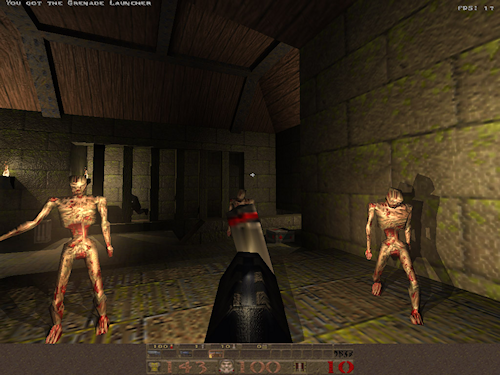
Surprisingly, the various roller coaster demos (which famously freak people out) did very little for me. I'm the type of heights-dreading person who feels apprehension just watching a parkour video and ends up with sweaty palms after playing a game like Mirror's Edge on a regular monitor, but I found the Oculus roller coasters to be a bit underwhelming. I suspect that will change once issues of judder and resolution are resolved.
Oculus Nausea
The nausea experienced when first using the DK2 was surprisingly intense. Just a few minutes of wandering around the low-intensity Tuscany Villa demo had me feeling queasy, and about 10 seconds flying in the AirDrift demo almost made me vomit. Regardless of the settings or passiveness of the environment, for the first few days it was not possible for me to use the DK2 for more than a few minutes at a time. An extended period of use would see me wearing the device for no more than 10 minutes, and only with tremendous effort.
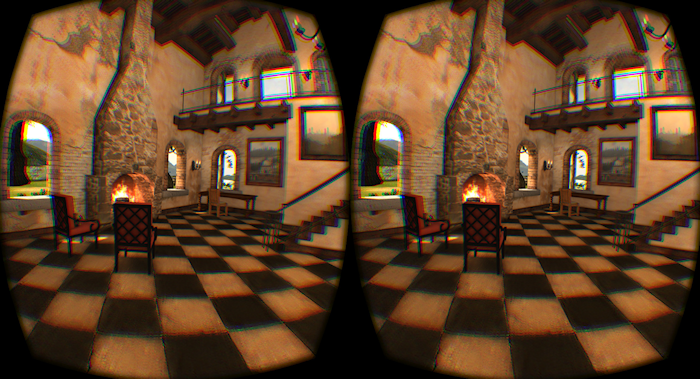
The nausea was of a surprisingly intense and persistent sort. Whenever I've experienced motion sickness when playing games, the sensation tended to grow gradually and quickly diminished once I'd left the computer screen. However, VR sickness seemed to onset immediately and persisted for a bit over two hours after I'd left the device behind. A sense of dizziness and unsteadiness remained after taking off the DK2, and I'd recommend anyone looking to try a VR headset ensure they're not needing to operate machinery or a vehicle for a few hours after their first attempt -- I'd never have trusted myself in a car or on a bike at that point.
The nausea and dizziness was so intense at first that I was concerned I would not be able to use VR at all. Fortunately, this has turned out not to be the case.
One quickly learns not to change position too quickly while wearing the VR headset. The sensation when swiftly turning my virtual body's view about was as if blood were being pressed to the side of my brain to cushion it from a sudden shock. Whether that was an illusion or an actual reaction from my nervous system is something I'll leave to the biologists and physicians, but the unpleasantness of the experience was very real.
I gained my 'VR legs' rather quickly and the discomfort was considerably reduced after a week of occasional use. Nausea diminished with each session using the DK2, and use of it for extended periods (30+ minutes) after about 10 days barely registered any sense of discomfort at all. It then became possible to skip through the various Oculus demonstration apps with ease and play games for an hour or so at a time without any difficulty. Flying in AirDrift became a breeze. Use of the device soon began to feel so natural that I would have likely misremembered my earlier nausea as being considerably less intense if I'd not made notes about it at the time.
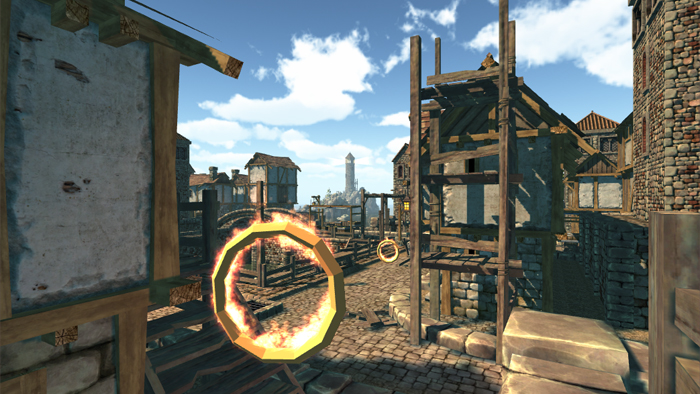
It's unclear to me whether my diminishing nausea was due to my senses growing accustomed to the VR environment, or my having optimized my computer's drivers and configuration to ensure the DK2 was being used in the best possible fashion. Others who have tried the DK2 device on my computer after I had finished its configuration and video driver optimization experienced no nausea issue whatsoever. So, either I should have spent more time configuring my system's drivers and DK2 configuration before starting to use the device, or I was just an unlucky outlier who was particularly susceptible to VR motion sickness.
Gaming With Oculus
The Direct to Rift mode for the DK2 worked flawlessly, with all games and tech demos suited for that mode running without issue. However, setting up Extend Desktop mode on my own computer to use Steam was a difficult experience which reminded me of the 'DLL hell' presented when installing a video card on Windows 3.1. That difficulty is no fault of Oculus or any other hardware/software vendor: The DK2 is beta development hardware, and my difficulties could have come from a variety of sources, from video card drivers to my monitor setup under Windows. I only mention these issues as a reminder that the DK2 is not consumer hardware: Everything might work for you right out of the box at this point, but anyone who purchases a DK2 should be prepared to spend a good amount of time configuring their system to ensure it works correctly.

Once Extend Desktop mode was enabled for my DK2, I tried out Half-Life 2 using Steam's beta VR client and found the game a new experience entirely. The screen door effect is still there, with pixels visible when you're looking for them, but the sensation of actually feeling 'inside' the game allowed me to quickly set that roughness aside. Even though the game was familiar to me, the VR immersion allowed me to pick out scenery details I'd not seen before, and I gained a sense of scale of my surroundings which had previously been missing -- I had no idea head crabs were so big!
Video With Oculus
Virtual movie theaters and home entertainment setups seem to be one of the most popular initial applications of VR displays, and I believe video will end up becoming the most popular use of the Oculus and similar devices in the future. Even early in my use of the device, I did not feel nausea when using the DK2 to passively view video and that use seems likely to be the gateway through which wider adoption of VR headsets will occur.
The ability to set whatever environment one would like for movie viewing (whether in a living room, your choice of theater and row, or just a floating screen), combined with the full sense of immersion and lack of interruption from the outside world delivered by the headset provides the possibility of a perfect movie experience. A VR display delivers the option of viewing regular two-dimensional or fully 3D video in whatever format one would like, whether an IMAX-sized screen, a fully surrounding 3D environment, or a small corner television set, all while remaining seated or reclined in a favourite chair, couch or bed. The low resolution of the DK2 still delivers the feeling of sitting a bit too close to an old CRT television, but the higher resolution to be expected from the consumer Oculus device will likely resolve that distraction entirely in time.
There is also the possibility of interactive movies, or fully 360' degree movie experiences which put you in the role of a character of your choice. The Birdy King Land Oculus demo gives a really good example of that -- you're a character IN the movie. However, as fun as interactivity and gaming is with the Oculus, easily delivered passive entertainment seems likely to become the 'killer app' for head-mounted VR displays. Often, people just want to lie back and relax, and a personal, isolated virtual movie theatre has the potential to perfectly deliver that experience on-demand.
Oculus Tips From Experience
If I could go back in time to the moment I started using the DK2, I'd give myself these bits of advice:
You should use the Rift configuration tools to set your Inter-Pupillary Distance (IPD) rather than using the value measured for your glasses. IPD for the Rift (and presumably other VR headsets) should match the value used when your eyes are focused to infinity (informally confirmed here by Oculus Founder Palmer Luckey), which is what the configuration tool provides. Using the IPD value set for your glasses will probably be incorrect.
Ensure your video drivers are up to date. If using an NVidia card, install and use the NVidia 'GeForce Experience' tool to simplify the upgrade of your video drivers. It saves a lot of hassle when identifying and applying the correct driver version.
Contact lenses are helpful but not necessary if you can see well without glasses. With natural eyesight, I would be incapable of reading a cell-phone held at Oculus distance from my eyes, but the corrective optics of the device's lenses extend that distance to remove any difficulty with viewing. VR resolution isn't sharp enough yet to justify concerns with fine visual detail, but that will probably change with consumer versions of the device.
Be sure to move slowly in the VR environment. If you're used to flicking the mouse around for a quick change in orientation in first-person shooter games, using the same gesture to move about in VR will probably feel uncomfortable at first and lead to nausea.
If you're taller than average, set the Player Height value in the Oculus settings to be lower. The people creating Oculus games and experience demos are likely to be of average height, and the environments will often feel uncomfortably cramped (as if you're about to hit your head on the ceiling) if they are set to take into account player height. Just set your configuration height at 5'5" and you're good.
Should I Buy An Oculus Rift DK2?
If you're looking to develop VR software right now then, yes, you should buy an Oculus DK2. You should be prepared to fiddle with system settings, drivers, incomplete documentation and the other hassles which come with being on the 'bleeding edge' of a technology, but the device is good to go for development.
If you're considering the development of VR software, are curious about the experience or just want to play games with the system, you should wait. The consumer versions of the Oculus Rift are going to be superior to the development kits in pretty much every way, and might even be less expensive at first. It will be worth the anticipation to wait a few more months for those to arrive since, once consumer versions of VR headsets are available, the early implementations now available with the Oculus DK1 and DK2 are probably going to be set aside to gather dust.